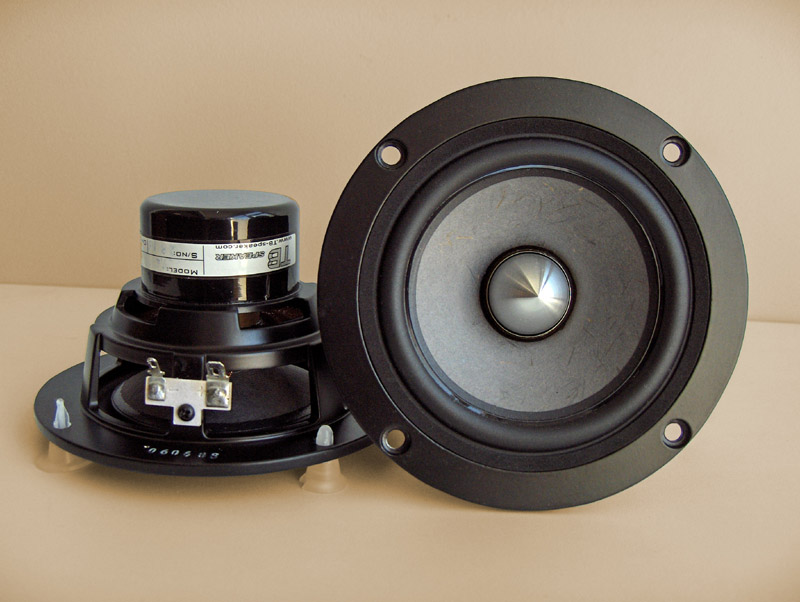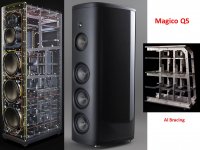In its raw form, your material will ring like a bell if not reinforced or damped somehow,
Your success will depend on a few factors. Depending on the actual aluminum alloy you have, there will be a wide range of resonance properties you'll have to deal with. Cast will be less resonant due to inconsistent grain structure, but it looks like what you have is T6, 6061 or 7 series extruded alloy. You will need some increase in wall thickness with the help of either plywood or other composite wood, plus some constrained damping layer in between if you care about how inert the enclosure will be.
I used to build speakers out of marble and granite. Marble rings like a church bell. It too needs alot of dampening. Granite is a bit better but not by much. MDF is bad for anything but subwoofers. Its just cheap heavy junk, unsuitable for high end fullrange designs without extensive damping and reinforcement. High grade marin plywood is by far the best cabinet material with the best compromise in stiffness and internal dampening. The novelty of using compromised materials for building enclosures has worn off for me. I would rather use tried and true good old marine birch plywood to get predictable results. Besides, you could always cover the enclosure with sheet aluminum or other material if you want that look.
Your success will depend on a few factors. Depending on the actual aluminum alloy you have, there will be a wide range of resonance properties you'll have to deal with. Cast will be less resonant due to inconsistent grain structure, but it looks like what you have is T6, 6061 or 7 series extruded alloy. You will need some increase in wall thickness with the help of either plywood or other composite wood, plus some constrained damping layer in between if you care about how inert the enclosure will be.
I used to build speakers out of marble and granite. Marble rings like a church bell. It too needs alot of dampening. Granite is a bit better but not by much. MDF is bad for anything but subwoofers. Its just cheap heavy junk, unsuitable for high end fullrange designs without extensive damping and reinforcement. High grade marin plywood is by far the best cabinet material with the best compromise in stiffness and internal dampening. The novelty of using compromised materials for building enclosures has worn off for me. I would rather use tried and true good old marine birch plywood to get predictable results. Besides, you could always cover the enclosure with sheet aluminum or other material if you want that look.
Last edited:
This is a real step forward. I have another 2 pieces of aluminium I can make into cabinets. These are fronts only, but thicker. Front is 8mm, sides are 10mm. I was wondering about making the back and sides from wood, but I could use aluminium. I have some braces that would work well to screw it together. Width is 155mm, height 380mm.
Yeah, that's a nice beefy step up right there. IMHO, mixing it up with wood elements, or any other material for that matter, makes for a nice contrast.
In its raw form, your material will ring like a bell if not reinforced or damped somehow,
Marble rings like a church bell.
Who'da thunk? That's surprising to me; I can definitely see the 'ringiness' of Al, but granite is something of a shocker.
I've not seen it used in cabinets, YET, but gray iron should be about as good as it gets. Just that you need a forklift
I once have had a pair of beautiful commercial speakers with aluminum enclosure here for a while, Goldmund Epilogue 1. They are $30K+ tiny monitors. I just kept them here for my friend who temporary moved to Europe.
No resonance, no ringing, but the speaker is EXTREMELY heavy so that it requires 2 person to carry this small monitor. Magico is also very heavy, so I guess it should be a lot of material is required to make the enclosure dead.
No resonance, no ringing, but the speaker is EXTREMELY heavy so that it requires 2 person to carry this small monitor. Magico is also very heavy, so I guess it should be a lot of material is required to make the enclosure dead.
Even cast iron rings, the only metal I can think of that doesn't is lead. Presumably ok if you don't lick it? Cheap " monkey metal " ( sink/mazak stuff ) isn't to bad, the more expensive alloy, the more it rings in general. Epoxy granite, or perhaps better epoxy slate might sound dead.
I don't doubt it. Interesting observation about alloys being more 'ringy.' I've never actually used metal in a cab. so I can only comment as to the general properties of certain metals.
I can say that highly graphitic cast gray iron is the gold standard when it comes to vibration damping, but this is regarding industrial machine tool applications. I've been experimenting with Durabar G2 for work holding applications to prevent cutter vibrations/chatter. Unfortunately I've yet to test it out and may never, as I found another application for gray iron, which is permanent mold Aluminum casting. So atm, I'm working out how to repurpose my G2 stock into permanent molds.
Here's a little about Durabar, very cool material:
I can say that highly graphitic cast gray iron is the gold standard when it comes to vibration damping, but this is regarding industrial machine tool applications. I've been experimenting with Durabar G2 for work holding applications to prevent cutter vibrations/chatter. Unfortunately I've yet to test it out and may never, as I found another application for gray iron, which is permanent mold Aluminum casting. So atm, I'm working out how to repurpose my G2 stock into permanent molds.
Here's a little about Durabar, very cool material:
Attachments
Very familiar with machining various alloys, even titanium and stainless. Cutter chatter is a huge problem, even with T6 and some higher Alu alloys. Coolant and feed rate are key.
A good alternative for damping Alu is using thin plywood walls inside and filling with sterilized sand. The sand filled sandwich enclosure method works very well with just thin plywood walls alone, its my favorite way to build smaller 2 way enclosures without losing too much internal volume by needing stiffeners internally.
A good alternative for damping Alu is using thin plywood walls inside and filling with sterilized sand. The sand filled sandwich enclosure method works very well with just thin plywood walls alone, its my favorite way to build smaller 2 way enclosures without losing too much internal volume by needing stiffeners internally.
Very trick idea, using the sand I mean. It begs the question, are further measures necessary? He's in that Magico 3/8" zone on the sides. The front is a little shy on thickness and general bracing on all the tall side walls is probably wise. The main problem, I would argue, is getting everything solidly fastened together, but if that's doable it should be as good as the A1, in theory.
We're talking the finer points of granite and iron so we've probably progressed 10x beyond the mechanical properties of an 8k$ set of Al bookshelves
Love turning some Ti, btw!
We're talking the finer points of granite and iron so we've probably progressed 10x beyond the mechanical properties of an 8k$ set of Al bookshelves
Love turning some Ti, btw!
Last edited:
About 15 years ago, I used two of these(Stainless steel wine chillers) to make computer speakers using tang band 4" bamboo Full ranges. Double walled, hollow, and with a weighted base, I filled them completely with hot wax to dampen the resonances. It was a fun project and they looked stunning. I also tried the titanium cones, which looked even better, but the bamboo sounded better. Both were an exact fit.
Convex Bottle Chiller
– Viski


Convex Bottle Chiller
– Viski


Last edited:
Some of the best sounding speakers today are made out of aluminium panels, so it must be great for cabinets.
It is, and metal in general for up to ~500 Hz depending on type, thickness since we want to raise the cab's resonance at least an octave above the XO point.
That, or push it a like amount under Fb, which means excessively heavy for even small cabs, so best for > ~ 500 Hz horns, etc..
Last edited:

There's some good ideas, then there's genius.About 15 years ago, I used two of these(Stainless steel wine chillers) to make computer speakers using tang band 4" bamboo Full ranges. Double walled, hollow, and with a weighted base, I filled them completely with hot wax to dampen the resonances. It was a fun project and they looked stunning. I also tried the titanium cones, which looked even better, but the bamboo sounded better. Both were an exact fit.
Convex Bottle Chiller
– Viski
May be wide of the mark, but I've been eying up some square cement planters. Cube shape, 25-30cm. If solid enough they'd be ready-made sides, bottom and top if placed on their sides. Then use a thick aluminium front and back like 12mm or more.
Square Box Contemporary Black Terazzo Light Concrete Planter by IDEALIST Lite H30 L30 W30 cm, 28 ltrs Cap.- from PS36.99 | Getpotted.com
Square Box Contemporary Black Terazzo Light Concrete Planter by IDEALIST Lite H30 L30 W30 cm, 28 ltrs Cap.- from PS36.99 | Getpotted.com
Baffle edge distortion must be reduced by cutting bevels into the front edges, or by machining large radius quarter-rounds into the front edges.
Silicon Valley company MAGICO with speakers like model Q5 is the leader in using aluminum for bracing and shaped external panels.
Silicon Valley company MAGICO with speakers like model Q5 is the leader in using aluminum for bracing and shaped external panels.
Attachments
The famous Realistic Minimus Seven was not an Aluminum enclosure as widely believed...it was a Zinc alloy. Zinc alloys with an Aluminum content makes for an outstanding enclosure, the absence of the fs ringing frequencies is very apparent. The sound is a very damped "thud".
Somewhere there are bars, sheets & extruded stuff available I'm sure.
--------------------------------------------------------------------------Rick......
Somewhere there are bars, sheets & extruded stuff available I'm sure.
--------------------------------------------------------------------------Rick......
The magico seem to be all talk and no data....wheres the data showing how Quiet the enclosure is compared to a properly built baltic birch cabinet....I highly doubt this is available...this, in my opinion, is the land of diminishing returns...the last few percent's of performance in order to claim a product as "king" and justify charging you a ridiculous price for the clout.... #provemewrong
- Home
- Loudspeakers
- Multi-Way
- Aluminium speaker cabinets
